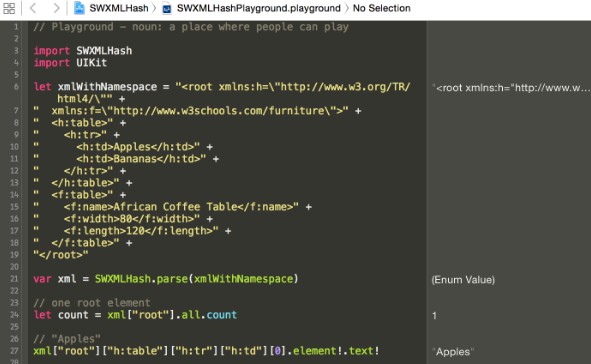SwiftyXML
SwiftyXML use most swifty way to deal with XML data.
Features
- [x] Infinity subscript
- [x] dynamicMemberLookup Support (use $ started string to subscript attribute)
- [x] Optional | Non-optional value access
- [x] Directly access Enum type value (enums extends from RawRepresentable)
- [x] Directly for loop in XML children nodes
- [x] Accurate error throwing
- [x] XML construct, formatting
- [x] Single source file
Sample XML:
<catalog>
<product description="Cardigan Sweater" product_image="cardigan.jpg" >
<catalog_item gender="Men's" >
<item_number>QWZ5671</item_number>
<price>39.95</price>
<size description="Medium" >
<color_swatch image="red_cardigan.jpg" >Red</color_swatch>
<color_swatch image="burgundy_cardigan.jpg" >Burgundy</color_swatch>
</size>
<size description="Large" >
<color_swatch image="red_cardigan.jpg" >Red</color_swatch>
<color_swatch image="burgundy_cardigan.jpg" >Burgundy</color_swatch>
</size>
</catalog_item>
<catalog_item gender="Women's" >
<item_number>RRX9856</item_number>
<price>42.50</price>
<size description="Small" >
<color_swatch image="red_cardigan.jpg" >Red</color_swatch>
<color_swatch image="navy_cardigan.jpg" >Navy</color_swatch>
<color_swatch image="burgundy_cardigan.jpg" >Burgundy</color_swatch>
</size>
</catalog_item>
</product>
</catalog>
With SwiftyXML all you have to do is:
let xml = XML(string: xmlContent)
let color0 = xml.product.catalog_item.size.color_swatch.1.string //"Burgundy"
// notice that, we use "$" prefix for subscript attribute
let description0 = xml.product.catalog_item.size.1.$description.string //"Large"
This is same as below, SwiftyXML will auto pick the first element as default:
let xml = XML(data: xmlFileData)
let color = xml.product.0.catalog_item.0.size.0.color_swatch.1.string //return "Burgundy"
What about if you input some wrong keys:
let xml = XML(data: xmlFileData)
// print the error
if let color1 = xml.product.catalog_item.wrong_size.wrong_color.1.xml {
// do stuff ~
print(color1)
} else {
print(xml.product.catalog_item.wrong_size.wrong_color.1.error) //.product.0.catalog_item.0: no such children named: "wrong_size"
}
Requirements
- iOS 8.0+ | macOS 10.10+ | tvOS 9.0+ | watchOS 2.0+
- Xcode 8
Installation
CocoaPods
You can use CocoaPods to install SwiftyXML by adding it to your Podfile:
platform :ios, '8.0'
use_frameworks!
target 'MyApp' do
pod 'SwiftyXML', '~> 3.0.0'
end
Carthage
Create a Cartfile that lists the framework and run carthage update. Follow the instructions to add $(SRCROOT)/Carthage/Build/iOS/SwiftyXML.framework to an iOS project.
github "chenyunguiMilook/SwiftyXML" ~> 3.0.0
Manually
- Download and drop
XML.swiftinto your project. - Congratulations!
Swift Package Manager
You can use The Swift Package Manager to install SwiftyXML by adding the proper description to your Package.swift file:
.package(url: "https://github.com/chenyunguiMilook/SwiftyXML.git", from: "3.0.2")
Usage
Initialization
import SwiftyXML
let xml = XML(data: xmlFileData)
Access XML and print out the error
if let color1 = xml.product.catalog_item.wrong_size.wrong_color.1.xml {
// do stuff ~
print(color1)
} else {
print(xml.product.catalog_item.wrong_size.wrong_color.1.error)
}
Catch the error
// catch the error
do {
let color = try xml.product.catalog_item.wrong_size.wrong_color.1.getXML()
print(color)
} catch {
print(error)
}
Access XML List
// handle xml list
for catalog in xml.product.catalog_item {
for size in catalog.size {
print(size.$description.stringValue)
}
}
Read Enums
// read enum value, Notice: enum need implements RawRepresentable
public enum Color : String {
case Red, Navy, Burgundy
}
if let c: Color = xml.product.catalog_item.size.color_swatch.enum() {
print(c)
}
Construct XML
let store = XML(name: "store")
.addAttribute(name: "description", value: "Ball Store")
.addChildren([
// attributes can be added in the initializer
XML(name: "product", attributes: [
"name": "football",
"weight": 0.453
])
])
// attributes can be added to an existing object
let product2 = XML(name: "product")
product2.addAttribute(name: "name", value: "basketball")
product2.addAttribute(name: "weight", value: 0.654)
// children can be added to an existing object
store.addChild(product2)
print(store.toXMLString())
// store xml output
<store description="Ball Store" >
<product name="football" weight="0.453" />
<product name="basketball" weight="0.654" />
</store>


